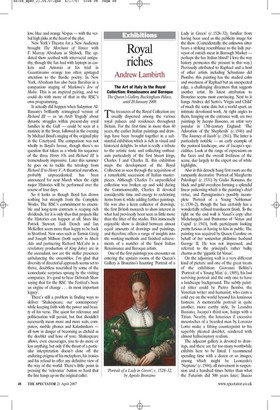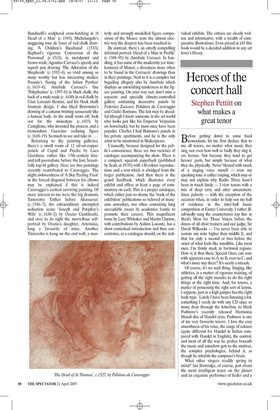Royal riches
Andrew Lambirth
The Art of Italy in the Royal Collection: Renaissance and Baroque The Queen’s Gallery, Buckingham Palace, until 20 January 2008 The treasures of the Royal Collection are usually dispersed among the various royal palaces and residences throughout Britain. For the first time in more than 40 years, the earlier Italian paintings and drawings have been brought together in a substantial exhibition which is rich in visual and historical delights. In what is really a tribute to the artistic taste and collecting enthusiasm particularly of the first Stuart kings, Charles I and Charles II, this exhibition maps the development of the Royal Collection as seen through the acquisition of a remarkable succession of Italian masterpieces. Although Charles I’s unparalleled collection was broken up and sold during the Commonwealth, Charles II devoted considerable time and energy to reclaiming items from it, while adding further paintings. He was also a keen collector of drawings, the first British monarch to show interest in what had previously been seen as little more than the litter of the studio. This immensely enjoyable show is divided between almost equal amounts of drawings and paintings, and therefore offers a range of insights into the working methods and finished achievements of a number of the finest Italian Renaissance and Baroque artists.
One of the first paintings you encounter on entering the upstairs rooms of the Queen’s Gallery is Bronzino’s haunting ‘Portrait of a Lady in Green’ (c.1528–32), familiar from having been used as the publicity image for the show. (Coincidentally, the unknown sitter bears a striking resemblance to the lady purveyor of ostrich meat in Borough Market perhaps she has Italian blood? I love the way history permeates the present in this way.) Previously attributed to Raphael and a host of other artists including Sebastiano del Piombo, this painting has the studied calm and sweetness of Raphael but an unexpected edge, a challenging directness that suggests another artist. Its latest attribution to Bronzino seems most convincing. Next to it hangs Andrea del Sarto’s ‘Virgin and Child’ of much the same date but a world apart, an intimate devotional work. At right angles to them, hanging on the entrance wall, are two paintings by Jacopo Bassano, an artist very popular in 17th-century England: ‘The Adoration of the Shepherds’ (c.1546) and ‘The Journey of Jacob’ (c.1561). The latter is particularly notable — an early example of the pastoral landscape, one of Jacopo’s specialities. Look at the range of expressions on the faces and the overall liveliness of the scene, due largely to the expert use of white highlights.
Also in this densely hung first room are the rampantly decorative ‘Portrait of Margherita Paleologo’ (c.1531) by Giulio Romano, the black and gold overdress forming a splendid linear patterning which is the painting’s chief virtue, and Parmigianino’s possibly incomplete ‘Portrait of a Young Nobleman’ (c.1530–2), though the face certainly has a wonderfully refined translucent finish. To the right on the end wall is Vasari’s copy after Michelangelo and Pontormo of ‘Venus and Cupid’ (c.1543), both participants looking pretty furious at having to kiss in public. The painting was acquired by Queen Caroline on behalf of her somewhat philistine husband George II. He was not impressed, and referred to the principal’s rather bulky charms as the ‘gigantic fat Venus’.
On the adjoining wall is a very different kind of picture and one of the great treats of the exhibition: Giovanni Bellini’s ‘Portrait of a Young Man’ (c. 1505), his last surviving portrait and the only one to have a landscape background. The subtly painted sitter could be Pietro Bembo, the Venetian writer and humanist, who casts a cold eye on the world beyond his luminous fastness. A memorable portrait in quite another, more earthy style, by Leandro Bassano, Jacopo’s third son, hangs with a Titian. Nearby, the luxurious if excessive moustaches of a bearded man by Lorenzo Lotto make a fitting counterpoint to his superbly pleated doublet, rendered with almost hallucinatory realism.
The adjacent gallery is devoted to drawings, and there are far too many worthwhile exhibits here to be listed. I recommend spending time with a dozen or so images, among which might be Leonardo’s ‘Neptune’ (c. 1504), all movement in suspension and a hundred times better than what the Futurists did 500 years later; Baccio Bandinelli’s sculptural cross-hatching in ‘A Head of a Man’ (c.1545); Michelangelo’s staggering tour de force of red chalk drawing, ‘A Children’s Bacchanal’ (1533); Raphael’s vigorous ‘Conversion of the Proconsul’ (c.1514), in metalpoint and brown wash; Agostino Carracci’s speedy and superb pen drawing ‘The Adoration of the Shepherds’ (c.1592–4), so vivid among so many worthy but less interesting studies; Poussin’s ‘Saving of the Infant Pyrrhus’ (c.1633–4); Annibale Carracci’s fine ‘Polyphemus’ (c.1597–8) in black chalk; the back of a male nude (c. 1630) in red chalk by Gian Lorenzo Bernini, and his black chalk fountain design. I also liked Borromini’s drawing of a column twisting sensuously like a human body. In the small room off, look out for the monotype (c. 1655) by Castiglione, who invented the process, and a tremendous Guercino reclining figure (c. 1618–19). So much to see and take in ...
Returning to the painting galleries, there’s a small room of 12 oil-on-copper panels of Cupid and Psyche by Luca Giordano, rather like 17th-century kissand-tell journalism, before the last, beautifully top-lit gallery. Here are two paintings recently reattributed to Caravaggio. The slight awkwardness of ‘A Boy Peeling Fruit’ in the forced diagonal between his elbows may be explained if this is indeed Caravaggio’s earliest surviving painting. Of more interest to me were the big dramatic Tintoretto ‘Esther before Ahasuerus’ (c. 1546–7), the extraordinary attempted seduction scene ‘Joseph and Potiphar’s Wife’ (c.1630–2) by Orazio Gentileschi, and over to its right the marvellous selfportrait by Orazio’s daughter, Artemisia, long a favourite of mine. Another Tintoretto is hung on the end wall, a mas terly and strongly modelled figure composition of the Muses: note the almost electric way the drapery has been touched in.
By contrast, there’s an utterly compelling informal portrait ‘Head of a Man in Profile’ (c. 1588–95) by Annibale Carracci. In handling, it has some of the modernity (or timelessness) of Manet, a directness more often to be found in the Carraccis’ drawings than in their paintings. Next to it is a complex but beguiling allegory also by Annibale which displays an astonishing tenderness in the figure painting. On your way out, don’t miss a separate and specially climate-controlled gallery containing decorative panels by Federico Zuccaro, Polidoro da Caravaggio and Giulio Romano. The last may be dreadful (though I know someone in the art world who looks just like his Emperor Vespasian on horseback), but he must once have been popular. Charles I had Romano’s panels in his private apartments, and he is the only artist to be mentioned in Shakespeare.
Unusually, because designed for the public’s convenience, there are two varieties of catalogue accompanying the show. There is a compact, squarish paperback (published by Scala at £9.95) with 140 colour reproductions and a text which is abridged from the larger publication. And then there is the grand hardback, which illustrates every exhibit and offers at least a page of commentary on each. This is a proper catalogue, which rather puts to shame the ‘book of the exhibition’ publications so beloved of museums nowadays, too often containing long unreadable essays by academics frantic to promote their careers. This magnificent tome by Lucy Whitaker and Martin Clayton, with contributions by Aislinn Loconte, has a short contextual introduction and then concentrates, as a catalogue should, on the indi vidual exhibits. The entries are clearly written and informative, with a wealth of comparative illustrations. Even priced at £45 this book would be a decided addition to any art lover’s library.



















































































 Previous page
Previous page